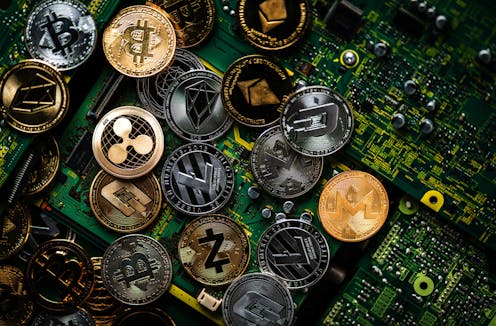why they've crashed and what it could mean for their future
- Written by Gavin Brown, Associate Professor in Financial Technology, University of Liverpool

If you had invested £100 (US$122) in the cryptocurrency Luna a month ago, you might have been quietly confident you’d made a sensible bet. But Luna’s value has since fallen drastically – at the time of writing, that £100 is worth around 4p (5¢).
Luna was by no means the only victim in a week where cryptocurrencies were down 30%[1]. Some have recovered to a certain extent, but this still represents an aggregate seven-day loss of over US$500 million (£410 million), prompting existential questions about the future of the market.
This crash was possibly triggered by a financial “attack” on the stablecoin Terra[2] (UST), which is supposed to match the US dollar but is presently trading at just 18 cents[3]. Its partner coin, Luna[4], subsequently collapsed.
An attack[5] of this kind is extremely complex, and involves placing multiple trades in the crypto market in an attempt to trigger certain effects – which can provide the “attacker” with significant gains.
In this case these trades caused Terra to fall, which in turn brought its partner coin Luna down too. Once this was noticed, it caused panic, which in turn sparked market withdrawals, which then caused further panic. Some (but not all) stablecoins rely to a large extent on perception and confidence – and once this is shaken, big falls can come into effect.
Crucially, the recent major falls in cryptocurrencies have called into question just how stable stablecoins[6] really are. After all, they are designed to have practically zero volatility by maintaining a “peg” to some other underlying asset.
Yet the effects seen this week spilt over in to the whole crypto space, to create single day losses akin to – or arguably worse than – a “Black Wednesday[7]” for crypto (Black Wednesday was the day in 1992 when speculators forced a collapse in the value of the pound). Even the leading stablecoin Tether lost its peg[8], down to 95 cents on the dollar, perhaps demonstrating the need for regulation[9]. For if stablecoins aren’t stable, then where is crypto’s safe space?
How investors respond will be key to the future of cryptocurrencies. We have already seen panic and despair, with some comparing this crash to a traditional run on the banks. But with bank runs[10], customers tend to be worried that their bank will be unable to give them their money, rather than worrying that their money has become worthless.
A more accurate comparison is with stock market crashes[11] where investors worry that the stocks and shares they hold may soon be worthless. And so far, reaction to this crypto crash suggests that a large section of crypto holders view their investments in a similar way.
Notwithstanding historical price volatility, there is a basic assumption often seen in investor behaviour: that the asset price will increase, and will keep on doing so. In this scenario the investor doesn’t want to miss out. They see the asset rising, consider it a “sure thing” and then invest.
Frequently buoyed by initial successes, the investor may then put in more. Combine this with social media and the fear of missing out on “inevitable” gains, and the investments continue.
Put simply, many will have invested in cryptocurrencies because they believed it would make them richer. This belief has no doubt been shaken.
But another motivation for investing in cryptocurrencies may be a belief in their transformational nature, the idea that cryptocurrencies will eventually replace traditional forms of financial exchange.
For these investors, any increase in the value of a cryptocurrency is a demonstration of the increasing power of cryptocurrency over traditional money. But likewise, a significant decline in the value of crypto is not simply a monetary loss – it is an ideological one.
At the same time though, this ideological stance creates an investor group far less likely to sell in the face of any sharp fall. And it is this group which may yet provide hope for the sector.
In established stock market crashes we talk of a return to “fundamental value”. The fundamental value of crypto is frequently assumed to be zero. However, perhaps there is at least some fundamental value which is based on belief. The size of the investor pool who own cryptocurrency because they believe in its long term future, and the promise of a new money, may determine that fundamental value of crypto.
Indeed, if we consider cryptocurrency investors as different groups with different motivations, we can better understand the behaviours we are seeing. Investors can perhaps take solace that we may have seen the worst of this crash and that better times may be ahead. But as any financial adviser will tell you, in crypto as in any other market, nothing is guaranteed.
References
- ^ down 30% (coinmarketcap.com)
- ^ Terra (www.terra.money)
- ^ presently trading at just 18 cents (coinmarketcap.com)
- ^ Luna (coinmarketcap.com)
- ^ attack (twitter.com)
- ^ stablecoins (coinmarketcap.com)
- ^ Black Wednesday (www.telegraph.co.uk)
- ^ Tether lost its peg (www.ft.com)
- ^ the need for regulation (theconversation.com)
- ^ bank runs (www.ecb.europa.eu)
- ^ stock market crashes (www.vox.com)
- ^ Shutterstock/Gorodenkoff (www.shutterstock.com)







